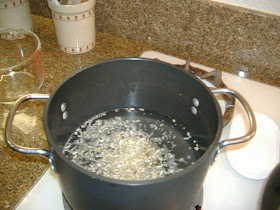 Yes Virginia, artichoke plants do grow well in the Sacramento Valley. Castroville and other coastal valley locations still have a big advantage over us when it comes to "perfect" weather for growing giant sized artichokes, but it doesn't mean we can't have a little fun ourselves. And judging by the size of these plants in the backyard, it looks like Venus and I are in for a pretty good year.
Yes Virginia, artichoke plants do grow well in the Sacramento Valley. Castroville and other coastal valley locations still have a big advantage over us when it comes to "perfect" weather for growing giant sized artichokes, but it doesn't mean we can't have a little fun ourselves. And judging by the size of these plants in the backyard, it looks like Venus and I are in for a pretty good year.At some point, in a few weeks, tender artichokes will form inside the center of this gargantuan plants and slowly grow upwards. I've learned some tricks through the years when it comes to growing artichokes in Sacramento, and it looks like this year that knowledge is really going to pay off. To put in bluntly, I've never seen artichoke plants quite this big before.
I'm in uncharted territory.
This is our second year for growing artichokes in the new North Natomas Back 40 (backyard), but the rootstock is actually quite a bit older. The roots of these plants came out of the old backyard at the old North Natomas home, located about ten minutes away from the new home. I had them confined in a very small area (all backyards in North Natomas are tiny). The first plants were put into a very small planter area in 2003 or 2004. And they grew well enough I suppose, although I had to force them to grow UP rather than OUT because I simply didn't have the room.
You can't tell by the photos because it's completely covered, but these artichoke plants are sitting in a 4X8 foot planter box constructed with cheap redwood fenceboard from the Home Despot. The box probably cost less than $30 to build (remember, I said CHEAP redwood fenceboard), and the nice planter-mix soil I put into this box probably cost a tad more than the box itself.
One of the first moves I made after building this box was to visit the backyard of the old home, which is now a rental. And I dug out every artichoke plant that I had growing in that small bed. We started with four in the first year -- but they had since expanded to about six or seven different rootstocks. After digging the plants out, I stuck them in some one gallon pots, put them in the back of my car, disassembled the old planter bed and raked decorative rock over the top.
If you were to visit the old home today, you'd never guess where the planter area had been.

Do you know what happened when the wife and I moved the rootstock and above-ground plants over to the new bed at the new home? If you're guessing "they thrived," WRONG. The plants immediately fell flat to the ground and started to shrivel up and die. I thought I had killed them. I was very upset. But then, a week later, I noticed a fresh, green sprout coming up from the center of a plant that had shown its distress by deflating completely. Then, I saw another -- and another. Pretty soon -- every rootstock was growing again.
The first harvest last spring was one for the ages. We got far more artichokes than I expected, and the plants kept on producing into early summer, when it gets hot and artichoke plants shut down from heat stress. You would never believe that these green monsters completely die back in the summer and everything has to be chopped away and removed, but that is exactly what takes place.
If last year's harvest was "one for the ages," I can't begin to imagine what we'll get this year. The plants have never been this big before -- EVER. And, the larger the plant, the larger the choke. The first artichokes of the season will be the largest, and judging from the size of the plants, they'll be the size of a catcher's mitt.
One thing you can't tell by the photos, and this really delights me to no end, is the number of ladybugs on these plants. The ladybugs love them, and I'll need them later this spring when the whiteflies and other bad bugs start attacking this plant. Ladybugs are the best natural control I know of, and if I make the mistake of spraying to control the bad bugs, I'll kill off the good bugs as well. And that is something I do not want to do.
I always thought that this 4X8 bed would offer more than enough room for artichoke plants. WRONG. As you can tell -- they're taking up every bit of space and more. Some plants are even leaning over the edge. That spells trouble, because these plants will fight to the death for room to grow, and I could lose a few if the base is put under so much stress that it snaps in half. That has happened before. And, since the plants are already starting to lean, I can see it happening again.
To prevent this from happening I will attach some eyelet screws to the 4X4 posts holding the fence up, then run string or twine around the bed, holding the plants in place. This has worked in the past.
This is just the first artichoke bed. I do plan on building a second bed this spring, and may consider adding a third. We have the room for it. And, by this time next year, we'll probably have artichokes coming out of our ears.
I can't think of a better fate, can you?





















